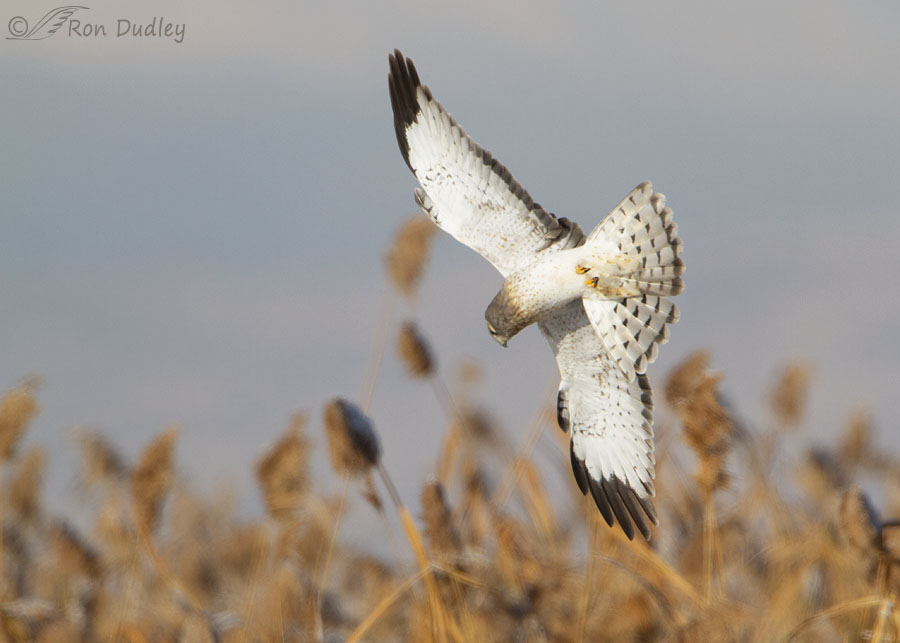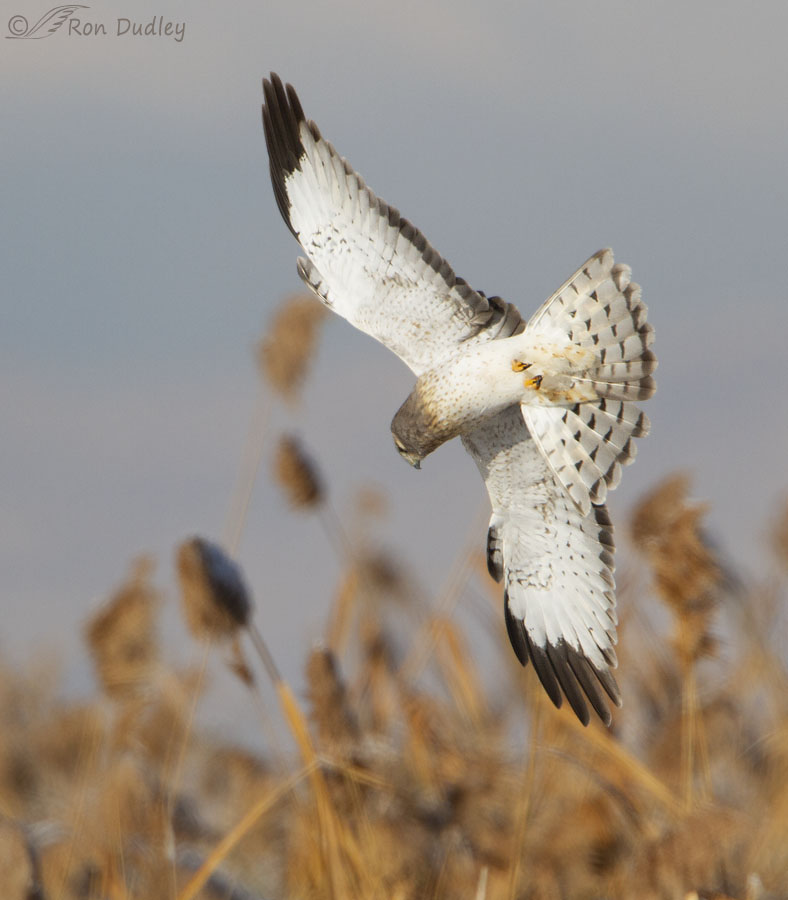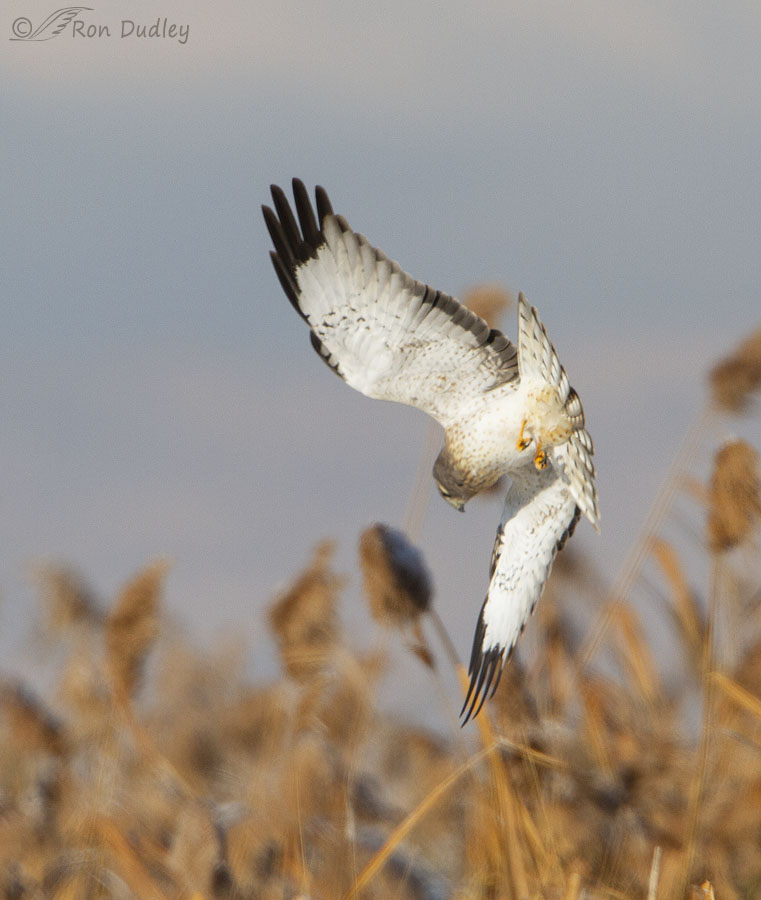The incredibly athletic twisting dives of Northern Harriers on prey are always impressive to witness (and difficult to photograph well) but when it’s an adult male, a “Gray Ghost”, for me at least it’s extra special.
The males are often called Gray Ghosts because of their striking plumage and spectral (ghostly) aura but I believe there’s another reason for that unusual moniker. Juvenile males look mostly like females until they develop adult plumage so to the casual observer most harriers appear to be females, making adult males seemingly more elusive and “ghostly”. Just my theory…

1/2500, f/7.1, ISO 500, Canon 7D, Canon EF 500mm f/4L IS II USM + EF 1.4 III Extender, not baited, set up or called in
Last night I stumbled upon a couple of 10 year old harrier photos I’ve never posted before and my reason for not posting them was a silly one – we can’t see the eye clearly. In my ignorance back then I thought a clear look at the eye was always essential but since that time I’ve come to realize that with behavioral shots it isn’t always necessary. In fact it often isn’t.
I just happened to have this male in focus as he was hunting low in front of a stand of phragmites and cruising right along when he spotted a vole directly beneath him and performed one of their patented lightning-quick aerial twists to dive straight down on prey. When that happens I’m usually not quick enough to push the shutter button before the bird is out of frame (or I’ve lost focus on it) but this time I was. Or maybe I just happened to push the shutter at the beginning of the dive by chance. Ten years later I can’t remember how it happened but I’d say the latter is probably most likely. These twisting dives happen fast!

Here’s a vertical composition of the same shot. If you have a preference for one version or the other I’d be interested in knowing which one. Personally I’m leaning toward the vertical but still undecided.

1/3200, f/7.1, ISO 500, Canon 7D, Canon EF 500mm f/4L IS II USM + EF 1.4 III Extender, not baited, set up or called in
By the time my shutter fired again I was beginning to lose focus on the harrier so this shot isn’t quite as sharp but I think it’s interesting to compare the two flight postures. At this point he was trying to stop his forward momentum (to our left) so he could drop straight down on the vole and here he’s put the brakes on with his right wing and tail.
By the next shot I’d lost him so I didn’t save any more images in the series and I don’t remember if he caught the vole or not.
But I’m glad I found the photos again, good look at the eye or not.
Ron


Beautiful pictures! You’ve talked about decreased sightings of Rough-legged Hawks and ?Swainsons during the past year. What about the number of Northern Harriers? Thanks, John
Fantastic shots Ron!
Charlotte
Vertical. And impressed at the skill and the speed (of the bird and also the photographer).
Thanks, EC – from both the photographer and the bird…
Ron, I prefer the horizontal because it shows off the terrain that the Harrier needs to ‘tackle’ in order to get its prey. I like the use of the tail to control the speed and almost looks like stopping in mid air. Thank you for great photos, Ron
“almost looks like stopping in mid air”
Alice, it actually IS like stopping in midair. Those “brakes” work incredibly well.
Vertical, all the way on this one. Thank you for sharing these shots — Harriercrobatics never cease to amaze. That flared tail is quite the rudder.
Thank you for sharing these shots — Harriercrobatics never cease to amaze. That flared tail is quite the rudder.
Thanks, Marty. I’m still leaning toward the vertical version myself but I see things I like about both.
You can’t go wrong with either composition, but I have a slight preference for the horizontal. It puts the bird more in the context of its habitat and a sense of that expansiveness. Just to get a good harrier photo is an accomplishment. Too many times tall grass or cattails seem to come between me and the bird and just when I’m ready to take the photo, they do one of those quick turns and my finger is not fast enough to catch the action well.
While juveniles look similar to females, I see them as more cinnamon than adult females. But, no way to tell the sexes apart in juveniles. The “Gray Ghost” males are certainly very striking, but I enjoy watching both sexes and all ages.
“I see them as more cinnamon than adult females”
Dan, of course you’re right about that. BNA puts it this way: “Juveniles are similar to adult female but are darker chocolate brown above and strongly rufous below”.
I thoroughly enjoy watching both sexes too. One of the reasons I was so happy to get this male in his twisting turn is that I believe the males, being smaller and more agile, perform that maneuver even more quickly than females do. So it’s even more of a challenge to get the shot.
That’s an interesting and observant speculation on the etymology of Gray Ghost.
I usually think the closer the better as in the vertical framing, but this time the more open expanse of the horizontal appeals to me more.
Thanks, Lyle. Maybe I’m right and maybe I’m not…
Just a thought… what about a square 1:1 crop? I have done a lot of these lately and you could still position your subject using the right 3rd of the frame. I dream of seeing a Northern Harrier…. great image no matter how you slice it.
Garrett, I appreciate the suggestion and for some folks that might be the best option but it isn’t for me. I’ve never liked square crops, not at all, so I avoid them whenever possible. I actually tried a 4/6 crop instead of the 5×7 in the first photo and even that was too “blocky” for me.
Nice shots. Yes, you always want the catch-eye, but in an action photo like this you would pretty much forget all about the eye had you not mentioned it. I like the first one, but then I always prefer horizontal over vertical. Very attractive with the white underside of the wings bordered by the brown and the tail feathers splayed out like that. Even though you only get a hint of the eye you can almost visualize the intensity of its view searching for that vole. And your post reminds me that I have yet to see a fully adult Harrier here. Something that I definitely look forward to.
I wish you luck in seeing your first Gray Ghost, Everett. Pretty neat birds.
Both! – horizontal gives more context while vertical REALLY shows off the Harrier…….;) Wonderful photos, Ron…. I love watching them hover over the field while hunting…..
I love watching them hover over the field while hunting…..
Judy, I guess I should have included a third option – “both”.
I vote for the vertical! Beautiful shot.
Thanks, Joanne.
Horizontal And Vertical, I’ll take them both and some more please.
Ha, that’s one solution. If we can’t decide simply take them both! And that’s exactly where I am at the moment…
Non-vertical for me as well. It gives me a better sense of how tight the turn is. Just Still at work. one of these guys this weekend. Stunning birds.
Thanks for your input, Arwen. When it comes to composition options it’s often difficult to choose because both versions have their pluses and minuses.
nonvertical
Thanks, Henry.
Love these! Both versions are fantastic but I have a slight preference for the vertical. When I compare #2 and #3 I have to smile…looking at the tail movement and slight drop of the feet in #3, I get the impression of ‘skidding to stop’. That back end just didn’t’ stop as fast as the front end. Always nice having those quick follow-up photos to remember the action.
“skidding to stop”
Ha, that almost makes me hear the squealing of the tires, Kathy.
And I think you’re right about the back end stopping more slowly, probably because there’s more wing surface area than tail surface area.